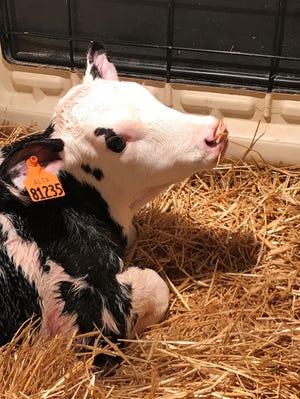Improving maternity environment results in healthier calves

Calf caretakers and feeders understand that calves are a lot easier - and more fun - to raise when they are healthy and grow well. As soon as a calf is born, the environment (maternity or other) begins to impact that newborn calf’s likelihood of thriving and risk of becoming ill.
Failure to provide a clean, well-managed maternity area and consistent, timely delivery of high-quality colostrum to newborn calves can contribute to failed passive transfer of IgGs in colostrum and an increased risk of exposure to harmful bacteria, such as E. coli, found in cow manure.
If a calf ingests manure laden with E. coli, or E. coli finds its way onto an unprotected umbilicus, it may travel to and infect the bloodstream (also known as septicemia) and eventually set up an infection in one or multiple joints. Other potential challenges following septicemia in young calves include scours, meningitis, pneumonia, and uveitis (eye inflammation), as well as death early in life.
Joint infections in young calves can be especially frustrating to treat and must be caught early for the best chance of a favorable outcome. Clinical signs that indicate infection in the joint include lameness, swelling, warmth over the joint, an apparent painful response when the joint is flexed or extended, and fever. A thorough physical exam to evaluate for the presence of fever and other infected joints or diseases, such as an umbilical infection, scours, or pneumonia, should be performed as soon as possible for these calves.
Prompt treatment with systemic antibiotics and pain medications should begin under the direction of your herd veterinarian. It is important that treatment continues until positive progress has been made, such as reduced swelling, improved ability to move, and fever reduction, which often takes one to two weeks.
A surgical treatment option for calves consists of a procedure in which the calf is sedated and the affected joint is flushed with a copious amount of sterile saline to remove the debris that has accumulated from causative bacteria and the invasion of inflammatory cells. This is repeated daily or as needed until the accumulating debris has subsided (about three to seven sessions total). Joint lavage is best used for acute cases of joint infection when caught early, and not for chronic cases or those non-responsive to other treatments.
The long-term outlook for calves with multiple infected joints, or calves that do not respond to treatment and are unable to walk normally, is poor. Even if these calves do recover, they will often lag in growth compared to their peers and have sustained damage to the cartilage and bones affiliated with the affected joint.
Work with your veterinarian to determine how to evaluate a calf’s recovery process, including a defined point in which humane euthanasia is the best option for calves that are non-responsive to treatment.
If you see more cases of joint infections than you’d prefer to treat, start by investigating maternity management and failure of passive transfer rates on your farm. Obtaining blood samples from calves less than 7 days old and measuring serum total protein levels remains the most efficient way to evaluate immune status of newborn calves. Improvements in the maternity environment and immune status of newborn calves will make everybody’s life easier, including that of your calves.

Dr. Jenn Rowntree is an associate veterinarian with Alta Genetics. Article reprinted with permission from VitaPlus.